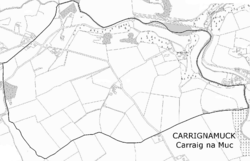Carrignamuck
Carrignamuck | |
|---|---|
| Irish transcription(s) | |
| • Derivation: | Carraig na Muc |
| • Meaning: | Rock of the pigs |
 | |
| Coordinates: 51°55′31″N 8°45′46″W / 51.92528°N 8.76278°W | |
| Irish grid ref | W475750 |
| Country | Ireland |
| County | County Cork |
| Barony | Muskerry East |
| Civil parish | Magourney |
| First recorded | c. 1573 |
| Settlements | Coachford, Dripsey |
| Government | |
| • Council | Cork County Council |
| • Ward | Blarney-Macroom EA |
| Area | |
| • Total | 147.21 ha (363.76 acres) |
Carrignamuck (from Irish Carraig na Muc 'Rock of the pigs') is a townland within the civil parish of Magourney and catholic parish of Aghabullogue, County Cork, Ireland. It is 363.76 acres in size, situate north-east of Coachford village, and north-west of Dripsey village.
One of the earliest references to Carrignamuck is contained within an Elizabethan fiant of 1573, when a pardon was granted to Donald m'Teig M'Cartie of Carignymucke.[1] This is likely to have been Donyll McTeige MacCarthy (tanist of Muskerry and brother of Sir Cormac McTeige MacCarthy of Blarney Castle) who resided at Carrignamuck Tower House. In a sketch map dated c. 1590 and titled the description of Muskery, the area is described as Carrigomuck.[2] The OS name book (c. 1840), in addition to mentioning the 'ruins, house and demesne of Dripsey Castle' describes Carraig na Muc as 'bounded on the north and east by the Dripsey River, on the south by Kilgobinet and Dereen townlands and in the Barony of East Muskerry', and mainly being 'under cultivation'.
The Down Survey Maps (1656-8) refer to it as Carrickmuck (Barony of Muskerry Map)[3] and Carrignemucke (Parish Map). The accompanying terrier states that 'on Carrignamucke stands a Castle and a Mill' naming the proprietor as Cormack McCallaghane Carthy who held 574 acres.[4] Smith in 1774 refers to 'the castle of Carignamuck'.[5]
By the early nineteenth century, the townland was commonly named as Carrignamuck, with Lewis in 1837 referring to 'the ancient castle of Carrignamuck'[6] and both the Ordnance Survey name book (c. 1840) and the OS 1842 surveyed map use the same name.
The majority of sources, such as O'Murchú (1991) [7] contend Carrignamuck derives from Carraig na Muc meaning 'rock of the pigs'. O'Donoghue (1986) holds Carrig na Muc as deriving its name 'from a pass in the nearby Dripsey River where it was customary to kill pigs which provided supplies of bacon for the castle ... while the Lord of Muskerry lived at Blarney, his Tanist always held Carrignamuck'.[8] Another version is that 'the proper name of Carrignamuck was Carrigcormac ... and that Carrignamuck Tower House was so called after Cormac Laidher McCarthy, the builder of Blarney Castle'.[9] Milner (1975) also subscribes to this alternative view.[10]
|
|
|
See also
[edit]- Dripsey Castle, Carrignamuck
- Dripsey Castle Bridge
- Trafalgar Monument, Carrignamuck
- Colthurst's Bridge
References
[edit]- ^ de Búrca, Éamonn (1994). The Irish Fiants of the Tudor Sovereigns; Vol. 2 1558-86. Dublin.
{{cite book}}: CS1 maint: location missing publisher (link) - ^ "The description of Muskery, Dartmouth map collection, Royal Museums Greenwich". Retrieved 24 February 2014.
- ^ "Down Survey map 1656-8 (Barony of Muskery)". Retrieved 13 April 2014.
- ^ "Down Survey map 1656-8 (Killcoleman Mattehy and Iniscarragh, Muskerry, Cork)". Retrieved 13 April 2014.
- ^ Smith, Charles. The ancient and present state of the county and city of Cork (vol. 1, 2nd ed.). Dublin, 1774.
{{cite book}}: CS1 maint: location (link) - ^ Lewis, Samuel (1837). A topographical dictionary of Ireland. S. Lewis. Retrieved 19 February 2014.
- ^ O'Murchú, M. (December 1991). "Place names of the parish of Aghabullogue". Coachford Record. 2.
- ^ O'Donoghue, B. (1986). Parish histories and place names of west Cork. Kerryman Ltd.
{{cite book}}: CS1 maint: location missing publisher (link) - ^ Fitzgerald, John J. (1930). "Bank holiday visit to Muskerry" (PDF). Journal of the Cork Historical and Archaeological Society. xxxv (142): 85.
- ^ Milner, Liam (1975). The River Lee and its tributaries. Cork: Tower Books.
- ^ a b c d e Histpop; Area, population and number of houses, Vol. II, Ireland, 1881, page 207
- ^ a b c HistPop; Area, houses, and population, Munster, Ireland,1911 Page 94
- ^ "CD153 - Cork Population by Private Households, Occupied and Vacancy Rate by Townlands, CensusYear and Statistic". data.gov.ie. Central Statistics Office. 2011. Retrieved 28 October 2018.
Carrignamuck, Magourney, Co. Cork [..] 24
- ^ "Grand Jury map of County Cork" (PDF). Retrieved 28 April 2014.

